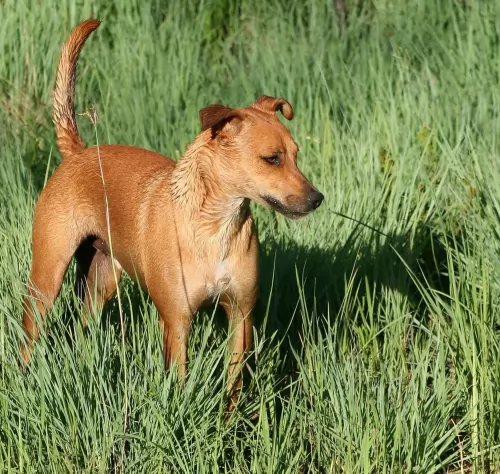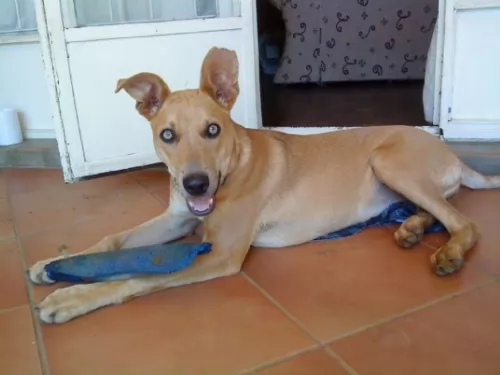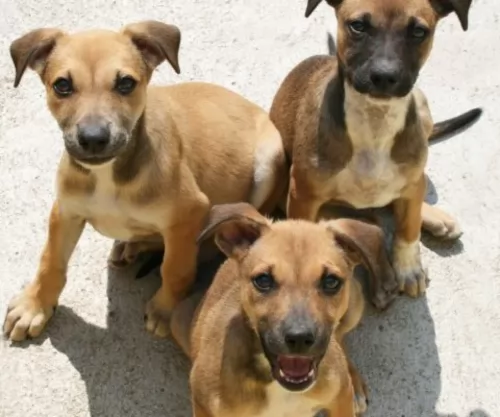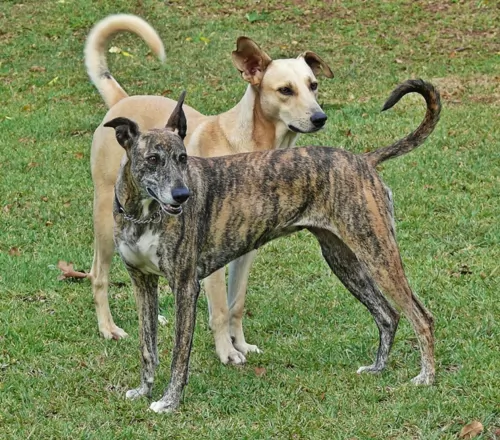 MyDogBreeds
MyDogBreedsBeagador is originated from United States but Africanis is originated from South Africa. Both Beagador and Africanis are of same height. Beagador may weigh 27 kg / 59 pounds lesser than Africanis. Beagador may live 3 years more than Africanis. Both Beagador and Africanis has almost same litter size. Beagador requires Moderate maintenance. But Africanis requires Low maintenance
The Beagador, the gorgeous medium size dog, is a mix of two beautiful breeds: Labrador retriever and a Beagle. This mix was made on purpose in the USA and resulted in a breed that got all the best of both breeds. The Beagador is an intelligent dog, very good in sports and very sociable. This made him very popular around the globe and one of the most desirable dog pets.
 Africanis is one of the original African breeds. This breed was not shaped by humans, but they went through the process of natural selection. Humans did not affect this breed by standard breeding practices. Through the history, this breed became stronger and stronger because only the strongest of the breed survived. Africanis descent is the early dog that is originally from ancient Egypt. Approximately 4500 BC was the period of first data about this breed.
Africanis is one of the original African breeds. This breed was not shaped by humans, but they went through the process of natural selection. Humans did not affect this breed by standard breeding practices. Through the history, this breed became stronger and stronger because only the strongest of the breed survived. Africanis descent is the early dog that is originally from ancient Egypt. Approximately 4500 BC was the period of first data about this breed.
As time passes through, Africanis became more and more popular through the whole continent. This breed migrated with people for thousands of years, and now, a modern Africanis is similar to Greyhound dog. The original Africanis can be found in tribes and more traditional people. One of the oldest breeds in the world is one of the lasts that has been recognized by Kennel Union of Southern Africa.
The Beagador got his height genes from the Beagle. That means that he is a bit shorter than the Labrador. Generally, they look a lot more like the Labrador, but in some cases, the puppies actually look more like a Beagle. So, actually, there is no rule about this. They have the short coat, usually very smooth. Sometimes it turns out softer and sometimes it doesn’t. They come in many colours, and they are usually two-coloured. So, the real truth is that Beagador breed appearance depends on the stronger genes between parent mix of Beagle and Labrador.
 Africanis origins from South Africa. The average Africanis weights 25-45 kg, with a height of 50-60cm, while females are slightly smaller. They are medium sized dogs who are friendly, but also independent and territorial. They can are good pets for training, but it requires persistent work.
Africanis origins from South Africa. The average Africanis weights 25-45 kg, with a height of 50-60cm, while females are slightly smaller. They are medium sized dogs who are friendly, but also independent and territorial. They can are good pets for training, but it requires persistent work.
The lifespan of Africans is 10-12 years, but lifespan always depends on health, genetics, and care of the dog. Therefore, if they are healthy and well cared they can live longer than average.
Litter Size variates a lot, so female can have 2-8 puppies.
The Beagador is a friendly breed. They will make no difference between adults and children, and they will bond easily even with complete strangers. But, children are usually more active than adults, so, in situations where he can choose, he will definitely choose to play with children. Some say that this dog never grows up in his heart. Maybe that is the reason they like children more.
Hunting, sports
The Beagador has the sweetest temper. But, for him, everything is a game. He might be a little bit too happy for other dog breeds. He likes to chase, jump, wrestle and be very physical with other animals. Some animals will enjoy this, but most of them won’t. If you start training him while he is still a puppy and socializing him from his early days, he will learn how to fit in and take a break once in a while.
The Beagador is very intelligent breed. They will be easy to train but only if you are experienced teacher. If you are not, they will try to get the things on their own way and you will end up being trained. It is advisable to use the reward technique, but make sure you don’t prise your Beagador with food. Early training is a must.
 Africanis is a very good and healthy breed. They are very intelligent and friendly breed. They are not an aggressive breed, but they tend to protect the master. Africanis is a natural guard dog. This breed is used to being alone because for the centuries they migrated close to humans, but they also have been independent.
Africanis is a very good and healthy breed. They are very intelligent and friendly breed. They are not an aggressive breed, but they tend to protect the master. Africanis is a natural guard dog. This breed is used to being alone because for the centuries they migrated close to humans, but they also have been independent.
Training Africanis is not very hard. They tend to learn very quickly. Positive training with awards is the best way to train your Africanis. The old-fashioned way of training dogs with punishment is not recommendable for Africanis. They are intelligent breed who requires patience and constancy.
They are very good with other animals too, but they need proper socialization. Africanis requires daily exercise so if you keep your dog in the apartment it should have few daily walks. Africanis can live in the apartments though.
Overall, they are very healthy breed, so with regular vet checks and proper care, they are perfect pets for the whole family since they are great and gentle with small children and kids.
The problems with their third eyelid, high risk of corneal wounds since they get too playful all the time, a disease that causes the dysfunction of the tear glands, conjunctivitis, glaucoma, cataracts, blindness.
When the puppies are born with skeletal defects that causes them to remain small.
Atopic dermatitis – very dry skin. If not treated, it will result in wound made by scratching the itchy and dry skin.
Since they have dropped ears, they don’t have the natural airflow and that causes the most of the infections.
 The great thing about Africanis is that this breed is very healthy. Thousands of years of evolution made this breed one of the toughest breeds in the world. They can survive very tough conditions. Africanis has a very healthy immune system too. It evolves so strong that there are no internal or external parasites that can harm the dog.
The great thing about Africanis is that this breed is very healthy. Thousands of years of evolution made this breed one of the toughest breeds in the world. They can survive very tough conditions. Africanis has a very healthy immune system too. It evolves so strong that there are no internal or external parasites that can harm the dog.
One of the first things you will notice is – you will never be able to feed your Beagador. He is always hungry, and he can always have just one more bite. But, this usually leads to very dangerous obesity. Make sure you feed him with prescribed portions: three times a day until he is 6 months old, and two times per day once he grows up. Their diet must be sugar-free.
The Beagador is one of the lovable breeds. They need a lot of love and they show a lot of love. They have playful nature and they get happy just by being with people. They shouldn’t be left alone for too long because they will easily develop the separation nervousness. They like to eat and they will use any chance to beg for food. That makes them very obese in no time. Keep in mind that giving them the prescribed proportion is for their own good. They need moderate grooming since they shed regularly. If you bathe them once in a month and brush them two times per week, they will do just fine.
The Beagador is a very active dog. They need daily activity. Since they are very friendly, you will have a great chance to meet a lot of people at the dog park! They will run with you, run along while you drive your bike, play in the water, fetch.
 Africanis has used to eat everything, so this breed does not require any special treatments. 2-2.5 cups of dry high-quality food would be more than enough to have healthy and well feed the dog. But have in mind that feeding the dog depends on daily activity and size. If the dog is more active, an extra cup wouldn’t be a problem for a dog to eat.
Africanis has used to eat everything, so this breed does not require any special treatments. 2-2.5 cups of dry high-quality food would be more than enough to have healthy and well feed the dog. But have in mind that feeding the dog depends on daily activity and size. If the dog is more active, an extra cup wouldn’t be a problem for a dog to eat.
Africanis puppy should eat more times per day than an adult dog. 3-5 meals per day of quality dry food are good measure to feed your puppy Africanis.
Since Africanis has short hair they are very easy to groom and care. Few brushes on a weekly basis with occasional bathing would be more than enough to have a clean and healthy dog.